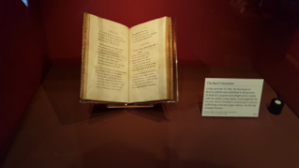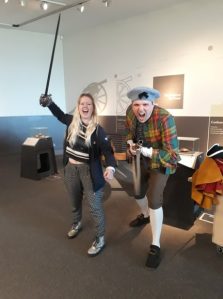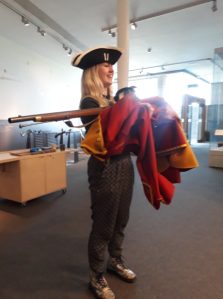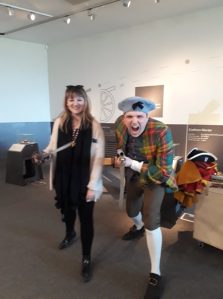Scotland
Meet the Team: Yves Laird
During this time of isolation and social distancing we find ourselves in, relying on digital technology to communicate has never been more important, and we wanted to help curb any loneliness and boredom by branching out with a new series of blogs about our staff. Our team were presented with ten questions to answer to help you to get to know them better. Next time you visit our Museum in Alloway, perhaps you’ll remember the name and the face of one of our staff members, helping you feel more connected #ForTheLoveOfScotland.
So without further ado, let us introduce to you…
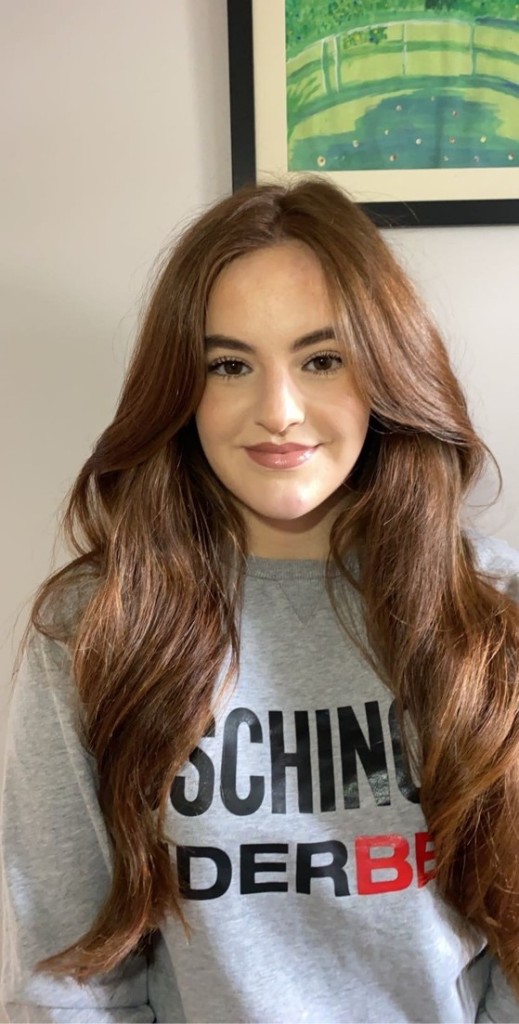
1. Name
- Yves Laird
2. How long have you worked at RBBM?
- 11 Months
3. What is your position at RBBM?
- Visitor Services Assistant (Catering)
4. What is your favourite thing about working (or best memory) at RBBM?
- I love being able to work among a great team of people in the heart of Alloway to provide our local community and worldwide visitors with service fit for a bard!
5. What is your favourite fact, song and/or poem by Robert Burns?
- As an English Literature student, not only do I appreciate Burns’s own work, but the works he provided inspiration for. His poetry is said to have inspired John Steinbeck’s 1937 novel ‘Of Mice and Men’, specifically by a line in the poem ‘To a Mouse’.

6. What is your favourite Scots word?
- Wheesht! Meaning be quiet as in “haud yer wheesht!”
7. Do you have any special skills/hobbies/talents? (Doesn’t need to be work related, let’s see your hidden talents!)
- I’m close to having an architectural degree, as seen in my Tunnocks teacake towers!
8. What is your dream vision/project?
- I would love to work in the emergency services! On a less realistic note, have my yet- to- be written novels published in the literary canon.
9. Who is your idol and why? (can be famous, could be your granny….up to you!)
- Prince! As a creative genius who wasn’t afraid to push boundaries, his commitment to his work and art form shines through his great works. The fact he wasn’t afraid to stand out from the crowd and was able to walk away from those who held him back is truly inspirational.

10. Where is your favourite place in the world and why?
- While the rain pours down 361 days of the year here, I’m proud to say home is Scotland. Nowhere can beat it with its rugged scenery, tranquil lochs and (mostly) friendly people!
Meet the Team: Chris Waddell
During this time of isolation and social distancing we find ourselves in, relying on digital technology to communicate has never been more important, and we wanted to help curb any loneliness and boredom by branching out with a new series of blogs about our staff. Our team were presented with ten questions to answer to help you to get to know them better. Next time you visit our Museum in Alloway, perhaps you’ll remember the name and the face of one of our staff members, helping you feel more connected #ForTheLoveOfScotland.
So without further ado, let us introduce to you…

1. Name
- Christopher Waddell
2. How long have you worked at RBBM?
- Seven Years
3. What is your position at RBBM?
- Downtrodden and defeated. Oh you mean work wise?! I am the Learning Manager.
4. What is your favourite thing about working (or best memory) at RBBM?
- I really enjoy when we get a great class of kids who engage with the site and subject matter. They make me laugh and inspire me sometimes with their outlook and knowledge of the world. I enjoy working alongside the team too, despite my continual joking and rude comments I really am very fond of them. Mostly.
5. What is your favourite fact, song and/or poem by Robert Burns?
- Fact – Burns was familiar with literary heavyweights – such as Alexander Pope – when he was in his mid-teens, and drawing inspiration, was able to compose pieces such as ‘Now Westlin Winds’ at such an early age. This qualifies for me the notion that he was a genius.
- Song – The Lea Rig
- Poem – a bit obvious but probably ‘Tam O’ Shanter’.
6. What is your favourite Scots word?
- Gowdspink, but a’hm no tellin ye whit it means, ye’ve tae awa an fun oot fur yersel!
7. Do you have any special skills/hobbies/talents?
- I can identify most plants and beasts you’ll see on a walk through the Scottish countryside and then tell a whole raft of dull facts to anyone who will listen.
- I can play the moothie and recite the script from ‘Goodfellas’(not at the same time).
8. What is your dream vision/project?
- To completely immerse myself in a rural idyll.
9. Who is your idol and why? (can be famous, could be your granny….up to you!)
- Loads of people, but in reality my late father who was great inspiration to me and a good friend and I miss him very much, and, a bit soppy here, my lovely wife because she puts up with me with amazing good humour and endless tolerance.
10. Where is your favourite place in the world and why?
- Difficult to choose between Sicily or Arran, both places I have been very happy and always in the company of my wife.
Meet the Team: Lauren McKenzie
During this time of isolation and social distancing we find ourselves in, relying on digital technology to communicate has never been more important, and we wanted to help curb any loneliness and boredom by branching out with a new series of blogs about our staff. Our team were presented with ten questions to answer to help you to get to know them better. Next time you visit our Museum in Alloway, perhaps you’ll remember the name and the face of one of our staff members, helping you feel more connected to our property.
So without further ado, let us introduce to you…

1. Name
- Lauren McKenzie
2. How long have you worked at RBBM?
- 6 months (Started in September 2019)
3. What is your position at RBBM?
- Events Manager
4. What is your favourite thing about working (or best memory) at RBBM?
- My favourite memory so far has been delivering the Burns programme in January. The team put in an immense effort to pull together all of the elements for the weekend and it was a very proud moment for me to see the success of this. I, of course, have to mention the incredible team of staff and volunteers that work at RBBM that make everything so enjoyable and easy!!
5. What is your favourite fact, song and/or poem by Robert Burns?
- My favourite Burns song is ‘My Love Is Like A Red, Red Rose’.
6. What is your favourite Scots word?
- It has to be ‘braw’. Braw means beautiful, pretty, attractive… you could call a lassie braw or you could say “it’s a braw day the day”.
7. Do you have any special skills/hobbies/talents?
- I have played in a brass band for over 12 years and somehow manage to find the time to compete on regional and national levels in between events at the museum!
8. What is your dream vision/project?
- My dream is to visit every continent in the world – only South America and Australia to go!!
9. Who is your idol and why?
- I am going to cheat a wee bit and have two – both my grannies! Although, I am biased, they are just the BEST in the world and have taught me everything I know.
- If it was to be someone famous, it has to be the Spice Girls (again, cheating because there is five of them!) I have loved them since a really young age – GIRL POWER!

10. Where is your favourite place in the world and why?
- I have travelled to a few places but there is nothing quite like being home in Ayrshire – it’s fair braw.
Celebrating Scots Language
As today is International Mother Language Day, our blog post explores the history of Scots language to celebrate and promote Scottish linguistic heritage.
Scots is descended from a form of Anglo-Saxon brought to the south-east of present day Scotland by the Angles (Germanic-speaking peoples) around AD 600. The video below, from The University of Edinburgh, illustrates the origins of Scots language.
Like many European countries, early Scots speakers primarily used Latin for official and literary purposes. The earliest surviving written poem in Scots, dated to 1300, is a short lyric on the death of King Alexander III (ruled 1249-1286) which appeared in Andrew Wyntoun’s work entitled The Original Chronicle:
“Qwhen Alexander our kynge was dede, That Scotland lede in lauch and le, Away was sons of alle and brede, Off wyne and wax, of gamyn and gle. Our golde was changit into lede. Crist, borne into virgynyte, Succoure Scotland and ramede, That is stade in perplexitie”.
Yet, the first Scots poem of any length called The Brus by John Barbour was recorded in 1375. Composed under the patronage of Robert II, this poem’s tale follows the actions of Robert the Bruce through the first war of independence.
The History of Scots from the 14th– 18th Century
Between the 14th and 16th century, writing in the vernacular thrived during the reigns of James III (ruled 1460-1488) and James IV (ruled 1488-1513): Scots language truly came into its own. This period’s Scots poets are known as medieval makars or master poets, after William Dunbar’s the Lament for the Makaris, for the great literacy culture that was produced in lowland Scotland. Dunbar was a virtuosic poet with an impressive range, varying from elaborate religious hymns to scurrilous bawdy verse.
Also a makar, King James VI (ruled 1567-1625) laid down a standard writers were expected to follow in his essay on literary theory entitled The Reulis and Cautellis. However, after James VI also became James I of England in 1603, Scots language and makars were no longer supported by the Royal Court. Pre-1603, James VI voiced the differences between English and Scots but now, as ruler of the British Empire, he attempted to Anglicise Scottish society for cultural, linguistic and political union of his kingdoms. Herein, the literary activity of 17th century Scots poets declined as many, like William Drummond of Hawthornden, decided to write in English instead. This change of language was encouraged by the Royal Court alongside the larger and more lucrative English publishing markets. In Scotland, all classes continued to write and speak in Scots but, for publications writers had their texts ‘Englished’.
The Great Scots Poets of the 18th Century
In the 18th century, under the 1707 Treaty of Union, Scotland joined England to form the new state of Great Britain and poets began to utilise an increasingly bilingual literary situation. Poets combined Augustan English poetry with Scots songs, tales and older poems to create a vernacular revival in Scots verse. The work of poets such as Allan Ramsay, Robert Fergusson and Robert Burns demonstrated the popularity and poetic nature of Scots as a literature. These poets, expressing a national identity, produced poems that were, and continue to be, widely read.

Allan Ramsay (1686-1758) was born in Lanarkshire and educated at Crawfordmoor Parish School. Following his mother’s death, Ramsay moved to Edinburgh to study wig-making and eventually opened a shop near Grassmarket. He was an eminent portrait painter and began writing poetry from the early 1700s. In 1721, Ramsay published his first volume as a blend of English language and Scots poems. He abandoned the wig-making trade to become a bookseller, opening a shop near Edinburgh’s Luckenbooths- this also became Britain’s first circulating library. Ramsay’s works, such as Tea-Table Miscellany (1724), The Ever Green (1724) and The Gentle Shepard (1725), laid the foundations for Scot writers like Robert Fergusson and Robert Burns.
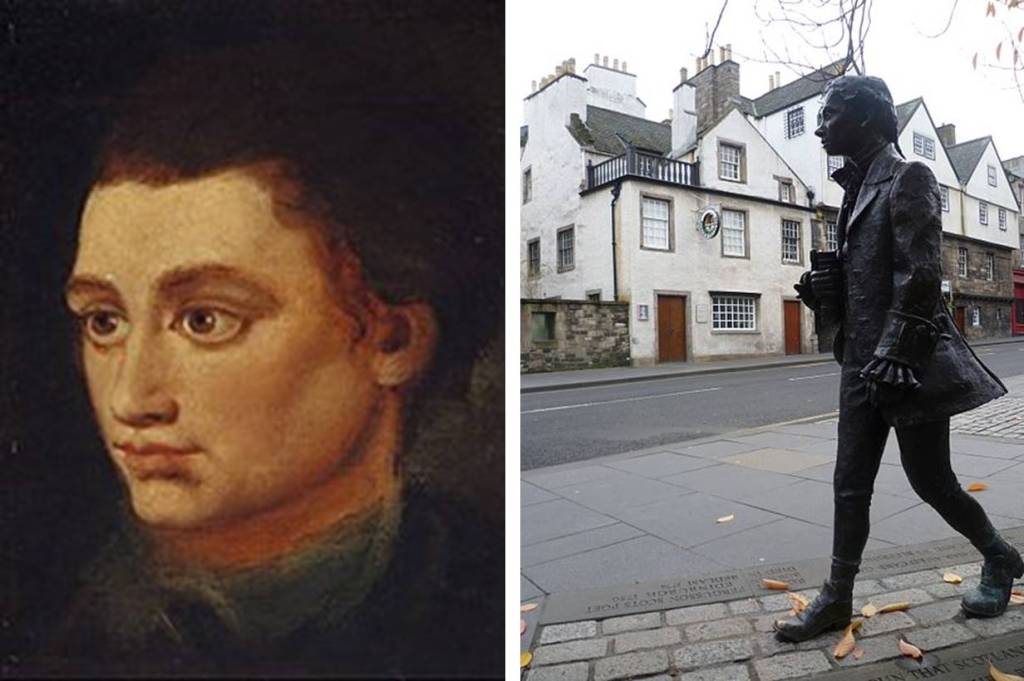
Robert Fergusson (1750-1774) was born in Edinburgh’s Old Town to Aberdeenshire parents. He attended St. Andrews University and became infamous for his pranks- for which he came close to expulsion. In 1771, Fergusson anonymously published his first trio of pastorals entitled Morning, Noon and Night. He amassed an exquisite range of about 100 poems, developing existing literary forms and contributing to contemporary debate. Aged 24, Fergusson experienced a fatal blow to his head falling down a flight of stairs, he was deemed ‘insensible’ and transferred to Edinburgh’s Bedlam madhouse where he later died. In 1787, Robert Burns erected a monument at his grave, commemorating Fergusson as ‘Scotia’s Poet’.
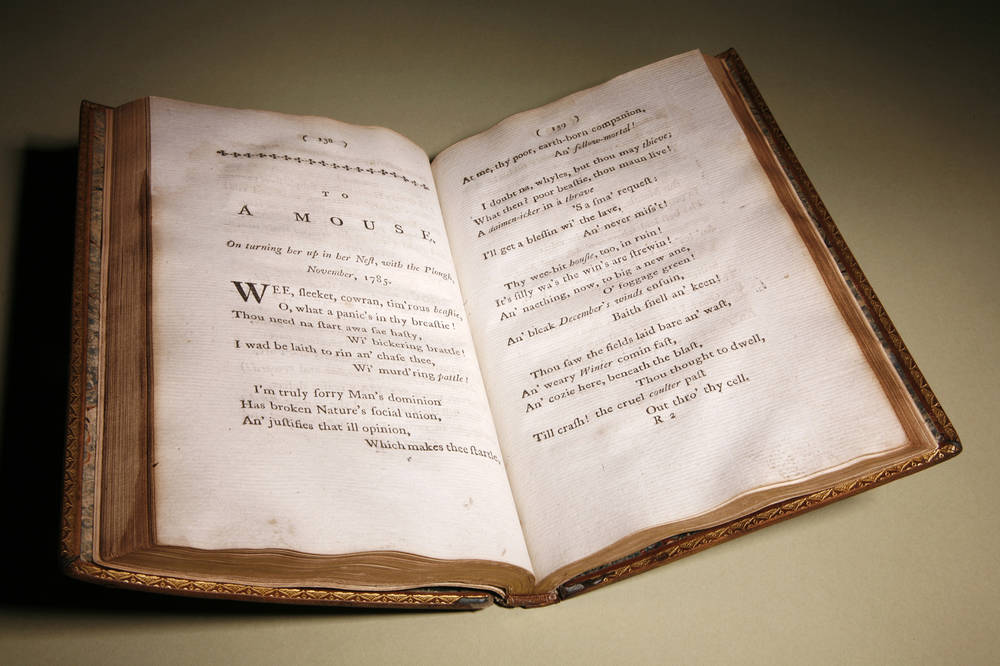
Robert Burns called Fergusson “my elder brother in misfortune, by far my elder brother in muse”. Clearly inspired by the poet, Burns adopted both Fergusson and Ramsay’s use of Scots words and verse to master his own poetry and advance Scots literature. In doing this, Burns became Scots language’s most recognised voice with poems and songs read and sung worldwide. The Robert Burns Birthplace Museum displays volumes and poems by Fergusson and Ramsay (below), highlighting the similarities to Burns’ work in terms of tone, format, subject matter and, of course, Scots language.

The History of Scots Post-Burns to the Present
In the 19th century, building on the work of Scots poets, novelist began combining English and Scots in their writings. More often, English was used for the main narrative and Scots voiced Scots-speaking characters or short stories.
After this period, the 20th century saw a radical renaissance of Scots poetry, primarily through Hugh MacDiarmid (pen name of Christopher Murray Grieve). MacDiarmid’s work The Scottish Chapbook, reassessed early Scots verse by using words from across different regions. Later, Edinburgh poet Robert Garioch reopened links to the Scots verse MacDiarmid devalued. Garioch, to a greater extent than MacDiarmid, developed a form of Scots united to any particular locality and produced a model that future writers could follow. Other 20th century poets, included Edwin Morgan, and his translation of Vladmir Mayakovsky’s poetry into Scots, as well as Tom Leonard’s Six Glasgow Poems.
Today, Scots language continues to thrive. In communities across Scotland, people use Scots as a language to write and speak. As the 2011 Scottish Census reported, there are 1.5 million speakers of Scots within Scotland, which is around 30% of the population.
So, why not challenge yourself? And join them? To celebrate Scots language and International Mother Language Day, learn a new word or a new phrase or more!
Check out the links below for more ways to learn Scots:
- On social media, we run a Scots word of the week campaign, encouraging our followers to guess and discuss what they mean. We often get international audiences commenting on the similarities between Scots and various European languages. Check it out on Facebook (@RobertBurnsBirthplaceMuseum) and Twitter (@RobertBurnsNTS).
- Search our blog for Scots language posts: https://burnsmuseum.wordpress.com/tag/scots-language/
- For Scots on Twitter, take a look at these pages: @lairnscots, @scotslanguage, @ScotsScriever, @tracyanneharvey @rabwilson1 and @TheScotsCafe.
- Join the Open University’s FREE online Scots language and culture course: https://www.open.edu/openlearncreate/course/view.php?id=2705
- Or, check out some of these websites: https://www.scotslanguage.com/
https://www.gov.scot/policies/languages/scots/
http://www.cs.stir.ac.uk/~kjt/general/scots.html
https://education.gov.scot/improvement/Documents/ScotsLanguageinCfEAug17.pdf
Gang oan, gie it an ettle!
A Blether Aboot the Scots Leid!

Fir twa hours oan Saturday 19th Oct masel an hawf a dozen ithir fowk wi a birr fir the Scots tongue speirt awa aboot oor language, or leid, in the Robert Burns Birthplace Museum biggin.
We blethert aboot hoo we feel whin we hear fowk yaisin Scots words, yon sense o connection that we feel an hoo the leid taks us back tae guid memories o whin we wir weans. It’s aa aboot hoo oor brains are wired an hoo certain pathways in oor harns licht up whin we hear language that we ken. The Scriever fir Scotland, Michael Dempster, explains this in a Ted Talk oan You-Rube, which is weel worth a wee swatch.
Gien that this is the International Year o Indigenous Languages, we jaloused aboot hoo maist linguists gree that Scots is a leid in its ain richt an hoo Scots is kent by oor ain government an the European Commission as wan o the 3 indigenous leids o Scotland, alang wi English an Gaelic.
We luiked at hoo Scots language hus evolved owre the centuries wi Brythonic, Anglo-Saxon, Norwegian an Scandinavian, French an Auld English influences as weel as fae the Celts an the Picts. An hoo, it’s kent as a Germanic leid wi close ties tae Auld English.
We speirt aboot hoo oor Scots leid hus maistly been a spoken leid, due tae hoo historic documents wir aften scrievit in Latin an French. Poetry hooivver hus aye buin scrievit in Scots, stertin wi the magneeficent poem BRUS scrievit aboot Robert the Bruce by John Barbour in the 1370’s.
We spaik aboot hoo, eftir the union o Scotland an England, the nabbery stertit tae learn tae read an scrieve in English, we jaloused that mibbe they thocht this wuid be beneficial tae them in terms o trade, status an siller. White’er thaur thochts wir, the ootcome wis a dingin doon o the Scots leid an the stairt o a penchant tae tell fowk speikin Scots tae “speik properly”.
We spaik o the Scottish enlightenment in the 18th century whin makars sic as Allan Ramsay, Robert Fergusson an Robert Burns hud the smeddum tae scrieve in Scots tae mak siccar the Scots Leid wis uphaudit tae this day. We jaloused that aiblins oor bonnie leid wid hae bin lost itherwise. We spaik o hoo, nooadays, wi the world gaun the way its gaun at the meenit, we are hell bent oan preserving oor leid, itherwise, wi media influences we micht aa end up wi transatlantic accents!! We got yokit in aboot this, speirin aboot hoo oor weans are sayin words lik “Trick or Treating” insteid o “gaun guisin”!!
We spaik aboot hoo literature, parteecularly fir weans, is being scrievit an owerset intae Scots mair an mair an hoo this is a gey guid way o airtin fir the future.
We aa hud different life experiences and thochts but we aa agreed that we want tae preserve oor rich an descriptive Scots leid an pass it oan tae oor weans an granweans.
A wheen o Scots words hae been dinged doon as bein “slang” an we luiked at some examples an whaur they micht originate fae;
- “A WEE STOATER” – meanin “first class” or a fine example o somehin, eg, a “stoater” o a goal, or a wee smasher. Nae doot related tae STOTTIT – BOUNCED and mibbe even tae STOT – an auld Scots word for a bullock.
- “UP THE SKYTE” – meanin pregnant. KYTE wis originally the Scots word fir belly. So if somebody’s “skyted” their belly hus gotten big, they are pregnant. Also the medical term for fluid in the abdomen is ASCITES (latin) from ASKITES (Greek).
- SCUNNERT – as in “ocht ah’m fair scunnert the day, ah cannae get oot ma ain road”, auld Scots an Northern English word, Robert Fergusson an Robert Burns baith yaisd it in their poetry. Literal meanin wis originally tae flinch / tae shrink back. Noo means “fed up.” Comes fae the 14TH century Norse word SKONERON.
- BLETHER – meanin tae chat, “hae a wee blether” or someone who is “a wee blether”, wee chatterbox, Originated fae the auld Norse word blathra or blaora.
- HUNKERS– ie “doon oan yir hunkers”, meanin squattin doon – Dutch or German in origin.
- WINTER DYKES – clothes horse – in the summer fowk yaist tae pit thaur claes owre stane dykes tae dry, as they hud nae washin lines, so in the winter they wuid dry the claes in the hoos, in front o the fire owre a wuiden frame, which they caad the “winter dykes”.
- SMEEKIT – nooadays meanin steamin fu’, intoxicated. Originates fae auld Scots word SMEEK meanin smoke or fumes so, in the case o the modern yis o SMEEKIT, the fumes comin fae somebody intoxicated wi alcohol.
- GUISIN – comes fae Scots an North England meanin “disguised as”. Swipperly bein taen owre by “Trick or Treating”.
- OXTER – armpit. Norse in origin – Dutch word is Oksel.
- REDD UP – as in “awa an redd up yir room”, yaisd in Scotland an Northern England, comin fae the word “rid”, “get rid of”.
- BARE SCUDDIE – goes back tae the 18 hunners, meanin nooadays naked, but originally meanin a wee fledgling burd that’s no got oany feathers.
We then brainstormed some mair Scottish words an phrases lik:
- TUMMLE THE CRAN(forward roll)
- FANKLE(mixed up), eg, Ah wuid get intae a fankle if ah tried tae dae a tummle the cran!
- GRUMPHIE (pig)
- PUNTIE UP (help tae sclim up)
- HUNTIGOWK (April fools day)
- BOAK (be sick)
- BRACE (mantelpiece)
- OWRE THE THRAPPLE (doon the throat), we hud a guid laugh mindin oor granny’s gien us butterbaas tae cure a sair throat! Gadz!
Eftir that we compared some scrievins in Scots Leid, yin lass read a poem scrievit in Doric fae Lallans Scots leid journal, an this lead tae a blether aboot Sheena Blackhall’s braw Doric poetry, sic as “The Check Oot Quine’s Lament.” Anither lass hud owreset Wordsworth’s “Composed Upon Westminster Bridge” intae Scots an anither lass hud us heehawin an laffin at some o her social media posts in Scots.
We hud a wee laugh at hoo a few o us in the group hud been threatened wi elocution lessons as weans. We also speirt aboot hoo Scots words vary fae airt tae airt an hoo we can get crabbit an frustrated aboot hoo tae spell Scots words, gien we huv never buin tocht this an are self tocht. This is whaur guid scrievins come intae thaur ain an we hud a luik at James Andrew Begg’s buik “The Man’s The Gowd for a that”, which ah hae read recently an it baith brocht back words ah hud forgotten aa aboot an tocht me new wans tae. As Scots Scriever Michael Dempster telt us in his Ted Talk “it fair lit up the pathways in ma harns.”

We read a cutty extract fae chapter 9, “The Killie Fleshers” pages 108 – 109, based oan a fictional blether set in Kilmarnock in 1786, atween a fermer chiel an the printer o the Kilmarnock First Edition, Johnie Wilson, wha is speirin aboot “this Rob the Rhymer” an hoo “at the stert ah wis sweirt tae tak it on, fir his verses are aa in the Scotch tung…since aa thaim that can afford tae buy buiks are learnin tae speak in English”. We felt this extract wis relevant tae the pynt we wir makin earlier aboot hoo Burns wis instrumental in preservin the Scots Leid an hoo he mak’d siccar it wisnae gauntae be dinged doon. No on his shift. An we are fair gled that Wilson did “tak it oan”.
At the hinneren oor tungs taiglt us that much that we didnae dae oany scrievin!! Hoo an ever, we greed that it hud been an awfy guid blether an we’ll dae it again at the neist Scots Leid wirkshoap oan Setturday 09.11.19 1pm tae 3pm in the Robert Burns Birthplace Museum biggin.
Aabody welcome. Aefaulds .
Tracy Harvey, Resident Scots Scriever fir Robert Burns Birthplace Museum

Bards, Burns an Blether in The Bachelors’

It’s owre twa hunner year syne The Bachelors’ Club in Tarbolton saw the young Robert Burns an his cronies speirin aboot the issues o thaur day. It is therefore a braw honour tae gie this historic biggin a heize ainst mair by bein involved in organisin and hostin monthly spoken word an music nichts in the place whaur Robert Burns fordered his poetic genius, charisma an flair fir debate.
The Bachelors’ Club nichts stairtit in March this year eftir Robert Burns Birthplace Museum volunteer Hugh Farrell envisaged the success of sic nichts in sic an inspirational setting.
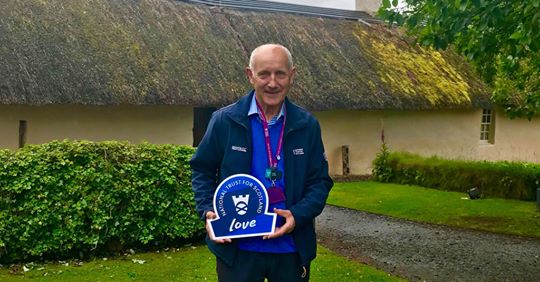
Tuesday the third o September saw the eighth session, an it wis wan we will aye hae mind o. Wullie Dick wis oor compère as folk favoured the company wi a turn.
Oor headliner wis Ciaran McGhee, singer, bard an musician. Ciaran bides an works in Embra an I first shook his haun some twa year syne at New Cumnock Burns Club’s annual Scots verse nicht. The company wis impressed then an agin at the annual “smoker” an at a forder Scots verse nicht. Ciaran traivelled doon tae Ayrshire tae play fir us, despite haen jist duin a 52 show marathon owre the duration o Embra festival.
Ciaran stertit wi a roarin rendition o “A Man’s a Man for a That”, an we hud a blether aboot hoo this song is as relevant noo, in these days o inequality an political carnage, as it wis twa hunner year syne, a fine example o Burns genius an insicht. Ciaran follaed wi Hamish Imlach’s birsie “Black is the Colour”, the raw emotion gien us aa goosebumps!! Ciaran also performed Johnny Cash’s cantie “Folsom Prison Blues”, an then Richard Thomson’s classic “Beeswing”, a version sae bonnie it left us hert-sair! Ciaran also performed tracks fae his album “Don’t give up the Day Job”.

The company wir then entertained by Burns recitals an poetry readins fae a wheen o bards an raconteurs. A big hertie chiel recited “The Holy Fair”, speirin wi the company on hoo excitin this maun hae buin in Burns day, amaist lik today’s “T in the Park”.
We hud “Tam the Bunnet” a hilarious parody o Tam o Shanter an Hugh Farrell telt us aboot the dochters ca’ad Elizabeth born tae Burns by different mithers, Burn’s first born bein “Dear bocht Bess”, her mither servant lass Bess Paton. Later oan cam Elizabeth Park, Anna Park’s dochter, reart by Jean Armour, an thaur wis wee Elizabeth Riddell, Robert an Jean’s youngest dochter wha deid aged jist 3 year auld. A “Farrell factoid” we learned wis that in Burns day, if a wee lassie wis born within mairrage, she was ca’ad fir her grandmither, if she wis born oot o wedlock she taen her mither’s first name. Hugh recited “A Poet’s Welcome To His Love-Begotten Daughter” fir us, the tender poem Burns scrievit, lamentin his love fir his first born wean, Elizabeth Paton.
We hud spoken word by various bards on sic diverse topics as a hen doo, a sardonic account o an ex girlfriend’s political tendencies, an a couthie poem inspired by a portrait o a mystery wummin sketched by the poets faither. In homage tae Burn’s “Poor Mailie’s Elegy”, we hud a lament in rhyme scrievit in the Scots leid, featurin the poet’s pet hen.
We learned o the poetess Janet Little, born in the same year as Burns, who selt owre fowre hunner copies o the book o her poetry she scrievit. This wummin wis kent as “The Scotch Milkmaid” an wis connected tae Burn’s freen an patron, Mrs Frances Anna Dunlop.

We also learned o hoo Burns wis spurned by Wilhelmina Alexander, “The Bonnie Lass of Ballochmyle” an hoo, eftir her daith, she wis foun tae hae kept a copy o the poem Burns scrievit fir her.
We hud mair hertie music fae Burness, performin Burns an Scottish songs sic as “Ye Jacobites by Name” an a contemporary version o “Auld Lang Syne” wi words added by Eddie Reader tae an auld Hebrew tune.
We hud “Caledonia” an “Ca the Yowes tae the Knowes” sung beautifully by a sonsie Auchinleck lass wha recently performed it at Lapraik festival in Muirkirk (oan Tibby’s Brig nae less!).
The newly appointed female president o Prestwick Burns Club entertained us on her ukelele wi the Burns song “The Gairdner wi his Paiddle” itherwise kent as “When Rosie May Comes in with Flowers”.
At the hinneren wi hud a sing alang tae Seamus Kennedy’s “The Little Fly” on the guitar an Ciaran feenished wi “Ae Fond Kiss”, interrupted by his mammy wha phoned tae see when he wis comin haim tae New Cumnock!
We hud sae muckle talent in The Bachelors’, that we didnae hae time fir a’body to dae a turn, so thaim that didnae will be first up neist time.

A hertie thanks tae a the crooners, bards an raconteurs an tae a’body in the audience fir gien up thaur time, sharin thaur talent an ken an gien sillar tae The Bachelors’ fund. Sae faur we hae roused £862 which hus been paid intae the account fir the keepin o The Bachelors’ Club.
Hugh Farrell is repeatin history by stertin a debatin group in The Bachelors’ on Monday 11th November, 239 year tae the day syne Burns launched it first time roon. Thaur will be a wee chainge tae the rules hooever, ye dinnae hae tae be a Bachelor an ye dinnae need tae be a man tae tak pairt!!
The Bachelors’ sessions are oan the 1st Tuesday o every month 7pm tae 10.30pm an a’body wi an enthusiasm for Burns is welcome.

Scrievit by Tracy Harvey, Resident Scots Scriever fir RBBM
Volunteers Week – Roger Alexander
For Volunteers Week, we asked our volunteers to write a blog post about their volunteering experience. Here’s Roger Alexander sharing some of his thoughts.
I retired from full time work eleven years ago; having spent the first five of those with The Conservation Volunteers, I came to RBBM just over six years ago as a “Buggy” driver. This involves meeting and greeting visitors, transporting them on the buggy between the Museum and Burns Cottage (or any other places the buggy will reach) and helping with other information and advice where I can.
As with most volunteering, the job rarely stops there. I now find myself helping out from time to time in all sorts of other ways, which I find very rewarding and stimulating, and it helps me feel part of the team.
Driving the buggy allows me to meet a whole range of interesting folk from all four corners of the planet and I am constantly amazed at how well Robert Burns is known even in the smallest and most remote of islands. However, these global travellers offer a wide range of stimulating conversation which is rarely restricted just to the “Bard”.
The Volunteers at RBBM also help run a Garden Shop, situated in the grounds of the museum, which offers a wide variety of goods manufactured by local crafters and is also a shop window for the RBBM itself. However, the main purpose of this venue is to raise funds for the restoration and improvement of the Burns Monument which is just one of the bold and innovative ideas being developed by the management team at RBBM.
One variation on the theme, which I particularly remember, was the great fun we all had on Halloween one year, volunteers and staff together, creating and acting out a costume drama incorporating the Burns Cottage, Poets Path and “Auld Kirk” and providing lots of “bloodthirsty” and scary moments for those visitors brave enough to come back after dark!
I find volunteering a great way to keep fit and active, meet new people and maintain a standard of life which rarely falters, and you may go a long way before finding a better place to do all this than with the team at RBBM and the beautiful countryside surrounding it.
Volunteers Week: Hugh Farrell
For Volunteers Week, we asked our volunteers to write a blog post about their volunteering experience. Here’s Hugh Farrell sharing some of his thoughts.
As a lifelong admirer of Robert Burns, a past president of four Burns Clubs and past secretary of a fifth, I volunteered to be a guide as soon as the National Trust came to Alloway. Indeed, wild horses could not have held me back! Confirmation that Robert Burns was the prime mover for my desire to become a volunteer.
To have the opportunity to immerse myself in the history of the Cottage and to find myself walking in the footsteps of the young Robert Burns is wonderful. Another plus is the opportunity to meet people who arrive from all around the world to visit the birthplace of Scotland’s National Bard who remains, in my opinion, The International Bard of Humanity. Then there are the thousands of schoolchildren who visit every year who we seek to inspire but who also inspire their guides. The children are encouraged to recite or sing their “Burns “ party pieces and a great many are really delighted to do so.
I always try to bring Robert Burns’ love of Scotland to the fore and note the light that comes into the eyes of visitors when I quote his poetry, songs or prose.
Communication is of course a two way process and whilst it pleases me to speak of the history of the Cottage, I am also intrigued to hear the tales of the visitors such as the American historian who informed me that Robert Burns was the first National Poet of the USA.
The first known Burns Supper was held in the Cottage in 1801, and continued to be held there until 1809, after which time it was relocated to the Kings Arms Hotel in Ayr.
The Supper was returned to the Cottage on 25th January 2016 and has now become a fixture on the calendar. It is organised by the volunteers of the Friends of the Museum, with superb support from NTS staff, and is a major fundraiser.
There are many activities to be involved in at RBBM, some for fundraising and some for fun. There are various crafts and activities, and even a chance to scare visitors at Halloween as they are guided through the gardens to the haunted Auld Kirk of Alloway! (They then went on to the Cottage where Doctor Hornbook, a Burns character, was performing an amputation!)
As a volunteer guide, I also take tours of the Robert Burns Birthplace Museum where I can expand on the life and times of our Bard as we view the great number of artefacts that are on display.
The question is often posed as to what is my favourite item, or song, or poem. The answer is always “too many to cover in such a short time.” However Robert Burns’ Kilmarnock Edition, where it all began, might be a good starting point.
I have written of the fantastic times that I have with our visitors but there is also so much pleasure in the camaraderie within the volunteer team and between volunteers and NTS staff members who support us in everything we do.
Retirement from the “day job” is the end of an era. Volunteering is the beginning of a better era.
Volunteers Week: Myra McLanaghan
For Volunteers Week, we asked our volunteers to write a blog post about their volunteering experience. Here’s Myra McLanaghan sharing some of her thoughts.
I didn’t really volunteer for the Trust – it sort of found me. I was a regular at the Wednesday Highlight talks at the RBBM and the Volunteer Co-ordinator approached me, thinking I would be interested. Of course, you always believe that you have nothing to offer and need qualifications etc.; but the thing is, you suddenly find that you have life experiences of qualifications and so I took the plunge of becoming a Volunteer.
I started off doing craft work, making rag rugs. So, with other volunteers, I commenced making a rag rug for Burns Cottage, where we would sit on a Monday afternoon cutting up fabric and creating our masterpiece. As people came through we found that nostalgia was a big part in discussion and visitors would discuss the rag rug, who made it in their family and what it was even called in different parts of the country. Overseas visitors were most intrigued, and children even tried their hand at putting a piece of material into the rug. The group are now on their third rug and we are now expanding into learning about weaving and dyeing of fabrics on the 18th century. From little acorns large oaks grow.
I have also become involved in a performance team who dress in 18th-century costume and perform the works of Burns. Our overseas visitors really appreciate us in costume and they feel part of what we are trying to tell them about life in Scotland during Burns’ time. Being a volunteer expands your experiences and confidence. I have a natural love for Scotland and volunteering has added a new dimension of meeting new people and making new friends and sharing a common love of Scotland and Robert Burns in the area where not only did I grow up, but he did too.

Myra (second from right) with some more rag ruggers, and their finished product, in Burns Cottage




